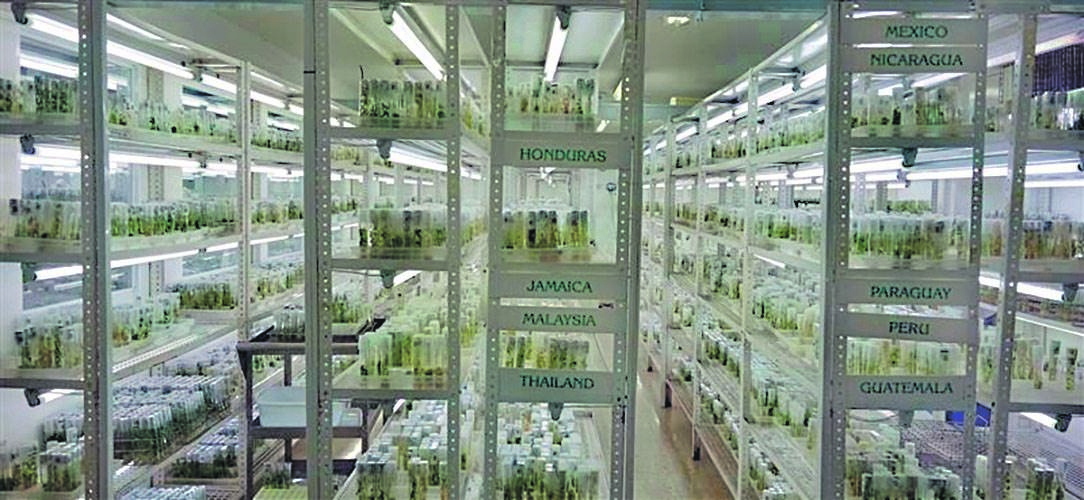
Colombian agronomist Javier Gereda gestures proudly towards the sturdy bean plant and bright green seedlings he has spent the past seven years nurturing back from agricultural oblivion.
“This is my son and his siblings,” he says with a smile, standing beside a row of high-tech fridges at a world-renowned seed bank that is using genetics to help farmers adapt to climate change and shock-proof global food systems.
“This is the only species of this bean that exists outside of its original habitat of Costa Rica, where it disappeared years ago,” Gereda says. “We’re the only source of extinct species like this.”
The seed from which Gereda grew his plants was stored in the world’s largest genetic library for beans, cassava and tropical forages, collected and preserved since the 1970s, according to the Consultative Group for International Agricultural Research (CGIAR).
READ: Seed banks 'critical' to saving plant species
Set amid sugarcane fields near the southwestern Colombian city of Cali, the Future Seeds gene bank is run by CGIAR’s Alliance of Bioversity International and the International Center for Tropical Agriculture (CIAT).
Rising demand for food due to a growing population and falling crop output caused by soil degradation and more extreme weather means researchers must breed more resilient crop varieties, experts say.
Stored in rows of steel shelves lined with glass test tubes and dried in airtight packets in a huge fridge chilled at minus 20 degrees Celsius (minus 4 degrees Fahrenheit), the bank houses a collection of 67 000 samples.
“It’s an insurance for the future,” scientist Joe Tohme, a geneticist who heads CIAT’s research projects on crops for nutrition and health, told the Thomson Reuters Foundation.
A new facility housing the collection has received about $17.2 million in funding so far from the Colombian government, and an additional $17 million donation from The Bezos Earth Fund, created by Amazon founder Jeff Bezos.
FOOD SUPPLY PRESSURES
The world used to cultivate more than 6 000 different plants. However, about 75% of crop diversity has been lost in the last century and UN experts say we now get about 40% of our calories from three main crops – maize, wheat and rice.
That means food supplies are vulnerable if climate change or war causes harvests to fail. Russia’s invasion of Ukraine has highlighted the fragility of food supply chains that, when interrupted, can cause rising prices and fuel hunger.
However, the seed bank holds genetic secrets that could help farmers adapt to rising temperatures and drier or wetter conditions by planting more resistant, nutritious and higher-yielding crops as a way to tackle hunger and malnutrition. One in nine people do not have enough food today, while the world population is expected to reach 9.8 billion by 2050.
With biodiversity loss increasing globally due to urban development, population growth and deforestation, preserving plant species to stop them disappearing for good is vital, experts say.
READ: Can plant-based diets make South Africa healthier?
Rising temperatures have also brought new and unexpected pests and diseases that ravage crops.
Tohme said:
‘UNIQUE LIBRARY’
In the seed bank’s laboratories, researchers pore over microscopes to prepare each seed for storage or research, selecting the optimal seeds and discarding any that are damaged. “In the gene pool, we look for special traits, seeds that can survive in hot temperatures and/or with a lack of water or lots of water. We pick the best of the best,” said Luis Guillermo Santos, a CIAT bean researcher.
The bank provides free seed samples to researchers and farmers – often farming cooperatives looking to plant seeds once used by their ancestors, or more resistant varieties. About 100 email requests from researchers and farmers are received each year for bean samples housed in the collection.
“Some farmers know the seeds they want, the same their grandfathers and those before them used. Or we can suggest which seeds to use according to their local conditions,” said Santos, adding the bank has distributed more than 500 000 seed samples to 142 countries across the world since 1973.
Over the decades, scientists using seeds from the gene bank have also developed more resistant and nutritious seeds, which is vital, as the Earth’s loss of genetic diversity means crops are less resilient to disease, invasive species, pests, habitat loss and climate change, said CIAT researcher Norma Manrique Carpintero.
Manrique Carpintero said:
In one success story, seeds collected decades ago from the Amazon rainforest in Ecuador and Colombia were used to produce a variety of cassava resistant to brown streak, a disease prevalent in parts of Africa.
In another, bean varieties with higher zinc and iron levels have been identified, helping tackle malnutrition and hunger, Tohme said.
TECH INNOVATION
Tapping into and extracting the information held in the seeds involves DNA extraction and gene sequencing – a process that deciphers and translates the genetic code of plants. At the new Future Seeds gene bank building that will be fully operational in December, scientists are leveraging genomics – the study of genetic material – and integrating this with big data technology to develop more resilient crops.
Using AI helps scientists speed up crop analysis, making it quicker to breed new varieties of plants capable of coping in extreme conditions. “It’s a library that needs translation, and new technology, like AI, to mine the data being used,” said Tohme.
Biologist Monica Carvajal-Yepes, who runs the Future Seeds digital bank, said it was “like having a digital passport ... a bank of knowledge to access biodiversity through data use”.
“The secret in the seeds is to be discovered. You look for secrets according to your needs,” she added.
The gene bank also aims to train a new generation of scientists by forging new research partnerships with local and international universities, said Tohme.
“The challenge is to maintain the collection,” he said. “It requires a generational commitment. It needs to be maintained for eternity.” –Thomson Reuters Foundation, the charitable arm of Thomson Reuters




 Publications
Publications
 Partners
Partners









